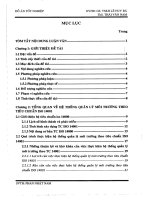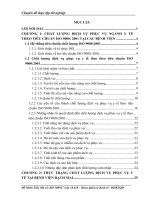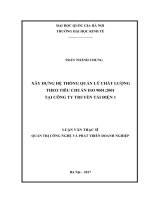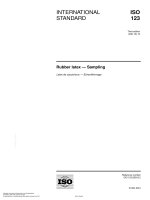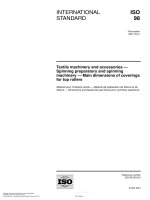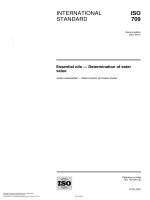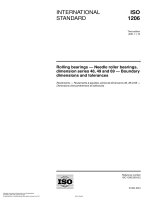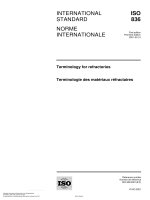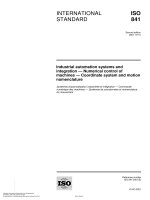Tiêu chuẩn iso 15165 2001
Bạn đang xem bản rút gọn của tài liệu. Xem và tải ngay bản đầy đủ của tài liệu tại đây (1.04 MB, 86 trang )
ISO
15165
INTERNATIONAL
STANDARD
First edition
2001-10-15
Fine ceramics (advanced ceramics,
advanced technical ceramics) —
Classification system
Céramiques techniques — Système de classification
Reference number
ISO 15165:2001(E)
--`,,```,,,,````-`-`,,`,,`,`,,`---
Copyright International Organization for Standardization
Provided by IHS under license with ISO
No reproduction or networking permitted without license from IHS
© ISO 2001
Not for Resale
ISO 15165:2001(E)
PDF disclaimer
This PDF file may contain embedded typefaces. In accordance with Adobe's licensing policy, this file may be printed or viewed but shall not
be edited unless the typefaces which are embedded are licensed to and installed on the computer performing the editing. In downloading this
file, parties accept therein the responsibility of not infringing Adobe's licensing policy. The ISO Central Secretariat accepts no liability in this
area.
Adobe is a trademark of Adobe Systems Incorporated.
--`,,```,,,,````-`-`,,`,,`,`,,`---
Details of the software products used to create this PDF file can be found in the General Info relative to the file; the PDF-creation parameters
were optimized for printing. Every care has been taken to ensure that the file is suitable for use by ISO member bodies. In the unlikely event
that a problem relating to it is found, please inform the Central Secretariat at the address given below.
© ISO 2001
All rights reserved. Unless otherwise specified, no part of this publication may be reproduced or utilized in any form or by any means, electronic
or mechanical, including photocopying and microfilm, without permission in writing from either ISO at the address below or ISO's member body
in the country of the requester.
ISO copyright office
Case postale 56 · CH-1211 Geneva 20
Tel. + 41 22 749 01 11
Fax + 41 22 749 09 47
Web www.iso.ch
Printed in Switzerland
ii
Copyright International Organization for Standardization
Provided by IHS under license with ISO
No reproduction or networking permitted without license from IHS
© ISO 2001 – All rights reserved
Not for Resale
ISO 15165:2001(E)
Contents
Page
Foreword.....................................................................................................................................................................iv
Introduction .................................................................................................................................................................v
1
Scope ..............................................................................................................................................................1
2
Normative references ....................................................................................................................................1
3
Terms and definitions ...................................................................................................................................2
4
Objectives.......................................................................................................................................................2
5
Individual classification fields......................................................................................................................3
6
Construction of a complete classification code.......................................................................................13
Annex A (normative) Application classification field ............................................................................................15
Annex B (normative) Chemical character descriptor field....................................................................................35
--`,,```,,,,````-`-`,,`,,`,`,,`---
Annex C (informative) Processing classification field ..........................................................................................60
Annex D (normative) Property data classification field ........................................................................................65
Annex E (informative) Bibliography to annex D .....................................................................................................74
Bibliography ..............................................................................................................................................................79
iii
© ISO 2001 – All rights reserved
Copyright International Organization for Standardization
Provided by IHS under license with ISO
No reproduction or networking permitted without license from IHS
Not for Resale
ISO 15165:2001(E)
Foreword
ISO (the International Organization for Standardization) is a worldwide federation of national standards bodies (ISO
member bodies). The work of preparing International Standards is normally carried out through ISO technical
committees. Each member body interested in a subject for which a technical committee has been established has
the right to be represented on that committee. International organizations, governmental and non-governmental, in
liaison with ISO, also take part in the work. ISO collaborates closely with the International Electrotechnical
Commission (IEC) on all matters of electrotechnical standardization.
International Standards are drafted in accordance with the rules given in the ISO/IEC Directives, Part 3.
Attention is drawn to the possibility that some of the elements of this International Standard may be the subject of
patent rights. ISO shall not be held responsible for identifying any or all such patent rights.
International Standard ISO 15165 was prepared by Technical Committee ISO/TC 206, Fine ceramics.
Annexes A, B and D form a normative part of this International Standard. Annexes C and E are for information only.
iv
Copyright International Organization for Standardization
Provided by IHS under license with ISO
No reproduction or networking permitted without license from IHS
© ISO 2001 – All rights reserved
Not for Resale
--`,,```,,,,````-`-`,,`,,`,`,,`---
Draft International Standards adopted by the technical committees are circulated to the member bodies for voting.
Publication as an International Standard requires approval by at least 75 % of the member bodies casting a vote.
ISO 15165:2001(E)
Introduction
The detail of the classification system has been developed by international collaboration under the auspices of VAMAS
Technical Working Area 14, and with support from the Commission of the European Communities, ASTM Institute of
Standards Research and the Japan Fine Ceramics Association. Its construction has followed an international survey of
requirements amongst manufacturing and user industries [1], discussions at an international workshop at Ispra, Italy,
June 1990 [2], a consultant's study [3], and a final report of the work of VAMAS TWA14 [4].
The use of this International Standard has been reviewed by VAMAS TWA14 in an international project to test and
demonstrate it. Based on the findings of this work, modifications agreed by VAMAS have been made to the original
VAMAS Report [4].
--`,,```,,,,````-`-`,,`,,`,`,,`---
v
© ISO 2001 – All rights reserved
Copyright International Organization for Standardization
Provided by IHS under license with ISO
No reproduction or networking permitted without license from IHS
Not for Resale
--`,,```,,,,````-`-`,,`,,`,`,,`---
Copyright International Organization for Standardization
Provided by IHS under license with ISO
No reproduction or networking permitted without license from IHS
Not for Resale
INTERNATIONAL STANDARD
ISO 15165:2001(E)
Fine ceramics (advanced ceramics, advanced technical
ceramics) — Classification system
1
Scope
This International Standard describes a system by which fine ceramics (advanced ceramics, advanced technical
ceramics) (see clause 3) may be classified. The system has been devised to cover all types of fine ceramics in the form
of inorganic precursors for ceramic powder production, powders, granular forms, fibres, whiskers, platelets, single
crystals, consolidated polycrystalline ceramics, amorphous (glassy) and composite materials and components in block,
thin film and coating forms. The structure of the classification is coded to be machine readable.
The classification system does not cover:
a) elemental carbon, except for specific ceramic forms such as diamond, vitreous carbon or chemical vapour
deposited (CVD) graphite;
b)
elemental silicon, elemental germanium and other elemental or compound semi-metallic substances other
than when they form an integral component of or precoursor for fine ceramics;
c)
traditional ceramics based on clay, including:
d)
1)
whitewares (e.g. tableware and fine porcelain);
2)
sanitary wares;
3)
floor and wall tiles;
4)
building ceramics (e.g. bricks and pipes);
unshaped and shaped refractories for tonnage applications.
This International Standard does not specifically cover hardmetal (cemented carbide) products, or products which are
mainly glassy, but the system can, in principle, be extended to cover such products. Its mode of use will be determined
by the objective behind its use. It is not the purpose of this International Standard to define how the system shall be
used, but examples are given of how it might be used. The user is able to define the coding combination and the level
of detail to suit a particular purpose. This International Standard provides only a flexible framework and a
recommended international coding system within which this might be done.
2
Normative references
The following normative documents contain provisions which, through reference in this text, constitute provisions of
this International Standard. For dated references, subsequent amendments to, or revisions of, any of these
publications do not apply. However, parties to agreements based on this International Standard are encouraged to
investigate the possibility of applying the most recent editions of the normative documents indicated below. For
undated references, the latest edition of the normative document referred to applies. Members of ISO and IEC
maintain registers of currently valid International Standards.
IEC 60672-2, Ceramic and glass insulating materials — Part 2: Methods of test
IEC 60672-3, Ceramic and glass insulating materials — Part 3: Specifications for individual materials
--`,,```,,,,````-`-`,,`,,`,`,,`---
1
© ISO 2001 – All rights reserved
Copyright International Organization for Standardization
Provided by IHS under license with ISO
No reproduction or networking permitted without license from IHS
Not for Resale
ISO 15165:2001(E)
3
Terms and definitions
For the purposes of this International Standard, the following terms and definitions apply.
3.1
fine ceramic (advanced ceramic, advanced technical ceramic)
highly engineered, high-performance, predominantly non-metallic, inorganic, ceramic material having specific
functional attributes
NOTE
Other terms which in whole or in part cover the scope of the above expression are in common use. The above term
is the preferred one in all circumstances.
3.2
classification field
set of categories related to one independent aspect or feature of the classification
3.3
classification element
single category in a classification field
3.4
code
alphanumeric string with a prescribed definition in terms of material attributes
3.5
coding element
part of the alphanumeric code from one classification field
4
Objectives
This International Standard provides a framework wherein fine ceramic (advanced ceramic, advanced technical
ceramic) products and materials can be classified for a variety of purposes including commercial statistics, market
surveys, materials identification, coding and data bases.
The present range of products that is encompassed by the term “fine ceramics” or its synonyms “advanced ceramics”
or “advanced technical ceramics”, or others, is enormous in breadth and complex in chemical character, form and
property attributes. Normally there are close interlinks between these factors. It has therefore been impossible to devise
a single hierarchical system, such as that used in IEC 60672-3 for electrotechnical ceramics for insulators or that in the
Harmonised Commodity Description and Coding System for goods or derivatives thereof. The system developed and
incorporated into this International Standard is novel in many respects in order to encompass all foreseen requirements
and purposes, and all raw and manufactured materials and applications, i.e. it has great flexibility.
For these purposes, an adequate classification of the diversity of materials and products in various stages of
manufacture may require the linking of chemical composition, form, processing method, material properties and
applications in any required combination. The system described in this International Standard has the capability of
classifying fine (advanced, advanced technical) ceramics by any combination of these fields in any sequence for any
desired purpose. The fields are described individually in the following sections. Annexes A, B, C and D provide a
coding method for each classification field of the system.
The user should select from the classification fields those relevant to his requirement, and place these in an order
prescribed for the particular purpose. Some possible combinations are described in clause 6.
2
--`,,```,,,,````-`-`,,`,,`,`,,`---
Copyright International Organization for Standardization
Provided by IHS under license with ISO
No reproduction or networking permitted without license from IHS
© ISO 2001 – All rights reserved
Not for Resale
ISO 15165:2001(E)
5
5.1
Individual classification fields
Introduction
Since the intention is to provide a means of classifying any combination of fields in any sequence appropriate to user
needs, each field is separately identified by a unique initial letter code:
¾
A = application
¾
C = chemical character
¾
P = processing methods
¾
D = property characteristic or data
The form of the product is closely related to chemical character and is incorporated into the chemistry code. If
appropriate, additional classification fields may be added in the same way. In each case these should be identifiable in
a coding string by a unique initial letter code.
For the purposes of computer recognition, a strict sequence of classification elements is not required, but for other
purposes, such as manual preparation of trade statistics or material specifications, the sequence of classification
elements should be chosen and fixed as preferred.
In the following description of code structures, the variable characters used in the code are:
¾
X = any appropriate single capital letter coding character
¾
n = any appropriate single numeric coding character
5.2
Classification field for application type
¾
electrical insulation, i.e. insulators for a wide variety of purposes;
¾
electronic/ionic conduction, i.e. electronic or ionic conductors for heating or functional purposes;
¾
mechanical functions, including wear, at or near room temperature;
¾
thermal and thermomechanical functions, where dimensional stability at raised temperature, heat
insulation, heat conduction or resistance to thermal shock are the principal functions, and where additionally
mechanical loads may be applied;
¾
nuclear functions, where the component plays either an active or a passive nuclear role;
¾
optical functions, where the component plays a functional role as an optical element in reflection, refraction,
transmission or absorption of electromagnetic radiation;
¾
chemical functions, including biomedical, where the component is employed for handling melts, chemicals,
solutions or atmospheres because of its resistance to attack by them and, in the case of biomedical materials,
a degree of bio-compatibility;
¾
magnetic functions, where the component possesses properties allowing a functional magnetic role;
¾
powder functions, where the fine ceramic is supplied in powder or granule form for use as such.
3
© ISO 2001 – All rights reserved
Copyright International Organization for Standardization
Provided by IHS under license with ISO
No reproduction or networking permitted without license from IHS
Not for Resale
--`,,```,,,,````-`-`,,`,,`,`,,`---
The initial character to denote the start of the “Application” string is “A”. This is followed by a three-digit number code as
listed in annex A for the application areas. In the list, applications are initially separated into a hierarchical series of
areas by the principal functions of the product as defined by:
ISO 15165:2001(E)
The first digit of the three-digit code is given as above by the principal physical function. The subsequent digits are nonhierarchical, and follow the listing given in annex A. To aid the identification of codes, an alphabetical index is also
given. Figure 1 shows a flow diagram for the selection of application codes.
It may not always be possible to assign a particular product to one of the listed codes. In such a case, the code
representing “Other functions” shall be employed, either within each of the above areas as appropriate, or failing
this under codes 980-999.
If the product needs to be classified as having a general applicability to a range of unspecified applications, the
general “unspecified” code (generally of form An00, except A400, but including A950) at the beginning of each
group shall be used.
EXAMPLES
5.3
Resistor cores
code A144
Wear resisting pads for slideways
code A326
Rubber dipping formers
code A820
Classification field for chemical character
5.3.1 The initial identifier indicating “chemical character” is “C”. Because the chemical character of fine ceramics
(advanced ceramics, advanced technical ceramics) can be complex, a flexible method of classification has been
devised. The one or two alphabetical characters that follow the initial “C” indicate the form in which the chemical
species exists (precursor, powder, solid ceramic, etc.). The following alphanumeric string indicates the species and,
optionally, the amount of it present, the relationship of a second species to the first (e.g. physical or chemical
admixture), etc. Details of the categories, their code letters and their uses are given in annex B.
Two formats of this string are given:
¾
a short format, intended for broad description of chemical character of common types of powder or ceramic
material;
¾
a long format, when more detailed chemical information is required, such as the individual chemical
components present and optionally their mass fractions.
5.3.2 The choice of whether to use the short-format or the long-format code is subject to agreement between
parties. However, it should be noted that converting from the short-format to the long-format code or vice versa is
not straightforward since the respective codings have different bases. Consequently, once a choice has been made
it should be adhered to.
NOTE
The short-format code is most appropriate for dealing with commercial products, sales statistics or inventories
where the distinction between products is based primarily on overall chemical type, without the need to define the composition
in detail. The long-format code is most appropriate for use where the precise chemical make-up of the product needs to be
identified, e.g. in data banks or in recording manufacturing processes.
5.3.3 The short-format code is a four-digit number (nnnn) in the range 5001 to 9999 found in annex B. This is
appended directly without punctuation to the chemical character identifier (C) and the form identifier (XX) to form a
code:
This code is used with the appropriate form identifiers for all types of ceramic precursor and product. The classification
code is terminated either by no further characters, or by one of the initial characters A, P or D (or additional defined
initial classification field codes) indicating the start of another classification field.
EXAMPLES
Dense high-alumina ceramic, 95 % alumina
CKB5040
Open porous calcium aluminosilicate ceramic (anorthite,e.g. metallurgical filter material)
CKG5555
Separated and floated whiskers of alpha silicon carbide
CWE6260
An open porous 2D woven silicon carbide fibre reinforced silicon carbide
CKT6320
4
Copyright International Organization for Standardization
Provided by IHS under license with ISO
No reproduction or networking permitted without license from IHS
© ISO 2001 – All rights reserved
Not for Resale
--`,,```,,,,````-`-`,,`,,`,`,,`---
CXXnnnn
ISO 15165:2001(E)
--`,,```,,,,````-`-`,,`,,`,`,,`---
Figure 1 — Flow diagram showing the selection of codes for application
5
© ISO 2001 – All rights reserved
Copyright International Organization for Standardization
Provided by IHS under license with ISO
No reproduction or networking permitted without license from IHS
Not for Resale
ISO 15165:2001(E)
5.3.4 The long-format code is constructed as shown in Table 1. Chemical species codes are selected from code
numbers 0001 to 4999 given in annex B. The sequence of “form” plus “chemical code” plus optional “amount” string
may be repeated as few or as many times as is required to define the product in the detail required.
Important aspects to note are:
1)
The code may be developed in the detail required to classify the product for the objective in mind.
2)
Compositional detail may be appended if appropriate to end-use requirements. Two options are available;
see Table 1 for two options, either an additional code number or a supplementary statement.
3)
The minimum classification long-format code is “form” plus one identified chemical compound; all
information beyond this point is non-mandatory.
4)
The classification code is terminated either by no further characters, or by one of the initial characters A, P
or D (or additional defined initial classification field codes) indicating the start of another classification field.
5)
Effective use of the long-format code requires detailed knowledge of the formulation and microstructure of
the product.
A flow diagram indicating the decision route to the identification and selection of codes is shown in Figure 2. The
following examples indicate the flexibility of use of the classification code in any appropriate way, while remaining
uniquely machine readable.
EXAMPLE 1
Alumina ceramic with 15 % by weight of unstabilized zirconia as a separate phase. Using Option 1 for the composition gives
(written with spaces for clarity):
6
Copyright International Organization for Standardization
Provided by IHS under license with ISO
No reproduction or networking permitted without license from IHS
--`,,```,,,,````-`-`,,`,,`,`,,`---
© ISO 2001 – All rights reserved
Not for Resale
ISO 15165:2001(E)
Table 1 — Construction of the long-format chemical character code
Description
C
Chemical character code string identifier
XX
One or two-letter code indicating the overall “form” of the product
nnnn
Four-digit chemical character code from the numerical range 0001 to 4999 (see annex B)
Optional
Option 1: coding element for indicating
“amount” of the species nnnn in the product
expressed as mass percentage, according to
the following code:
n
1 u1%
2 > 1 % to10 %
Option 2: If the precise composition in
percentage or parts per million terms is to be
expressed, the figure is placed in
parentheses (..) after the species code,
percentage being indicated by a following
letter “C” and parts per million by a following
letter “M”.
The figure may be preceded by “<” or “>” to
signify less than or more than a given
amount, respectively.
3 > 10 % to 30 %
4 > 30 % to 50 %
5 > 50 % to 70 %
6 > 70 % to 90 %
7 > 90 % to 99 %
--`,,```,,,,````-`-`,,`,,`,`,,`---
Code element
8 > 99 %
If the value is undefined or undefinable, this
character is omitted.
XX (**)
Two letters indicating how a second species is mixed in relation to the first when in the same
form of product, e.g. for a specified second component in a two-species powder or ceramic,
or an impurity.
nnnn
Four-digit chemical character code for the second species.
n
Option 1
Option 2
Optional single digit coding percentage, by
mass, of second species as defined above.
Optional supplementary statement coding
quantity, by mass, of second species, as
defined above.
(**) The sequence is repeated from (**) for third and subsequent species as necessary.
7
© ISO 2001 – All rights reserved
Copyright International Organization for Standardization
Provided by IHS under license with ISO
No reproduction or networking permitted without license from IHS
Not for Resale
ISO 15165:2001(E)
Figure 2 — Flow diagram for selection of codes representing chemical character
--`,,```,,,,````-`-`,,`,,`,`,,`---
8
Copyright International Organization for Standardization
Provided by IHS under license with ISO
No reproduction or networking permitted without license from IHS
© ISO 2001 – All rights reserved
Not for Resale
ISO 15165:2001(E)
EXAMPLE 2
Alumina ceramic with 15 % by weight of yttria stabilized zirconia as separate phase, yttria content in the zirconia not defined but
less than 1 % by weight overall. Using Option 1 for bands of composition gives (written with spaces for clarity):
--`,,```,,,,````-`-`,,`,,`,`,,`---
Option 2 defining the zirconia content at 15 % gives (written with spaces for clarity):
EXAMPLE 3
Sodium borosilicate glass of defined composition 71 % SiO2, 12 % Na2O, 17 % B2O3, using Option 2 for exact percentages
gives (written with spaces for clarity):
9
© ISO 2001 – All rights reserved
Copyright International Organization for Standardization
Provided by IHS under license with ISO
No reproduction or networking permitted without license from IHS
Not for Resale
ISO 15165:2001(E)
EXAMPLE 4
Silicon carbide whisker-reinforced alumina/unstabilized zirconia with unspecified composition. The compositional definition
option is not invoked, and gives (written with spaces for clarity):
For this particular case with unspecified percentages, the short form CKW5190 could be used with equal value.
NOTE
It may not always be possible to assign a particular product to one of the listed codes. In such a case, the code or
codes representing “Other” chemical species should be used, either within a chemical group for the long-form code [e.g. “Other
chromites” (2119)] or within a generic ceramic type for the short-form code [e.g. “Other glass-ceramics” (9999)].
5.4
Classification field for processing
In cases where the method of processing the ceramic needs to be identified as part of the overall code string, for
example in internal inventories or data bases, this can be performed using a simple string. The initial letter is P,
followed by three digits selected from the listing given in annex C, i.e.:
Pnnn
This can be repeated as many times as is required to define adequately the process or processing route adopted. For
example, the processing code for a ceramic body might have the appearance:
P203P302P403P502P804
indicating that a chemically precipitated powder (P203) was used, which was spray dried (P302) prior to isostatic
pressing (P403), followed by sintering in air (P502). The component was then surface ground (P804).
5.5
Classification field for property characteristics or data
5.5.1 Many ceramic products are developed for specific property attributes appropriate to particular end uses. If it
is required to provide a classification element to define the “properties” or “characteristics”, this is done using a
code with an initial letter “D” (data), followed by a string of 3 to 6 numerical characters defined according to the
matrix in annex E. The first numerical character defines the property class, and the second the property type within
that class. Where appropriate, details of the properties are coded in subsequent numerical characters.
NOTE
It is envisaged that property classification elements could be expanded into a more-detailed data base when this is
desired, the other classification elements being employed to define uniquely the chemical character, applications and any other
feature of the material or component.
10
Copyright International Organization for Standardization
Provided by IHS under license with ISO
No reproduction or networking permitted without license from IHS
© ISO 2001 – All rights reserved
Not for Resale
--`,,```,,,,````-`-`,,`,,`,`,,`---
A flow diagram for the selection of property data codes is shown in Figure 3.
ISO 15165:2001(E)
Figure 3 — Flow diagram for the selection of codes representing data
--`,,```,,,,````-`-`,,`,,`,`,,`---
11
© ISO 2001 – All rights reserved
Copyright International Organization for Standardization
Provided by IHS under license with ISO
No reproduction or networking permitted without license from IHS
Not for Resale
ISO 15165:2001(E)
¾
adequate to indicate simply this fact, or
¾
where it is not possible to ascribe a numerical value because there are no standardized procedures for giving
single-valued data, or
¾
there are no standardized or recognized test methods
the code is limited to the first three numerical characters. The citing of property characteristics in this manner shall
be taken to imply that the property is important for the function of the material, either by design of the material or by
the application for which it is intended.
EXAMPLES
An acid-resistant material
D802
An electro-optic material
D617
A material designed for (unspecified) thermal shock resistance
D303
5.5.3 Where it is appropriate to use numerical property values, properties are divided into numerical bands of
values as determined by a specified test method. The appropriate band can be selected using the fourth numerical
character. When desirable or appropriate, the property band may be qualified by use of a fifth numerical character
indicating the temperature range in which the property has a value in the selected band. With particular reference
to electrical properties, a sixth numerical character may be selected to indicate the frequency range relevant to the
property data. The frequency character shall always be used in conjunction with the temperature character to avoid
ambiguity.
EXAMPLE 1
A material with room-temperature flexural strength of 600 MPa:
EXAMPLE 2
o
An electrical insulator with loss tangent 5 ´ 10– 4 at 400 C and 10 MHz:
12
Copyright International Organization for Standardization
Provided by IHS under license with ISO
No reproduction or networking permitted without license from IHS
© ISO 2001 – All rights reserved
Not for Resale
--`,,```,,,,````-`-`,,`,,`,`,,`---
5.5.2 For cases in which one or more properties are seen to be of relevance in the classification of a ceramic
product, but where it is either
ISO 15165:2001(E)
5.5.4
If more than one property characteristic is required, the code D is repeated, i.e.:
DnnnDnnnnnnDnnn ......
represents three property features of particular relevance. These coding elements can be placed in any sequence
without change of meaning.
EXAMPLE
A material with thermal conductivity 40 W m-1 K-1, dielectric loss tangent 5 ´ 10-4 at 10 MHz and flexural strength 600 MPa, all
o
at 400 C:
D20164D609444D30154
The first two elements in this example are taken from the previous examples for single elements, and the third signifies the
thermal conductivity classification.
5.5.5 Optionally, a “supplementary statement” may be added to the classification code in order to indicate the
test method being used, a test method parameter, or other relevant attribute, e.g. colour. The supplementary
statement is enclosed in parentheses (..) and immediately follows the Dnnnnnn code.
EXAMPLE
Taking the previous example and adding the test methods and the colour of the product gives:
D20164(ISO 14704, 4-point bending, 40 mm span)D609444(IEC 60672)D30154(EN 821-2 and specific heat) D403(white)
5.6
Other classification fields
While not a defined part of this International Standard, additional classification fields may be used for further
features associated with a product as required by the application of the classification. If it is desired to include such
information, the classification fields should be constructed as agreed tables of codes in the form:
Xnnn
where X is a unique and unambiguously identifiable initial classification field character, and nnn is a three-digit
code from an agreed table. In this form, the additional classification elements remain unique and machine
readable.
Examples of attributes which could be coded in this way include:
¾
date of coding
¾
manufacturer's name
¾
country of origin
6
Construction of a complete classification code
The classification method described above may be used to assemble a code of any length to any level of detail
appropriate to the end-use requirements. By using unique letter identifiers at the start of each classification element an
individual element is easily identifiable in the combined code, which can then be constructed in any appropriate order of
classification fields.
The complete code comprises the individual coding elements in any agreed order, and shall be written as a continuous
string of characters with no gaps or punctuation.
It is the purpose of this International Standard to provide only a framework for classification rather than to prescribe
exact formats of codes for specific end functions. The system is sufficiently flexible to cover many envisaged purposes
by the appropriate agreed methods of selecting and ordering the coding elements. However, it is recommended that
unless otherwise required, the short format chemistry code is used.
--`,,```,,,,````-`-`,,`,,`,`,,`---
13
© ISO
2001 –forAll
rights reserved
Copyright International
Organization
Standardization
Provided by IHS under license with ISO
No reproduction or networking permitted without license from IHS
Not for Resale
ISO 15165:2001(E)
The following examples are given to illustrate the potential applications.
EXAMPLE 1
To survey markets or to compile trade statistics for fine ceramics, a trade organization might require
compilation of sales data by its members by classifying their products according to the criterion:
application + short-form chemical character
The classification code would appear as:
AnnnCXXnnnn
where XX defines the form of the product of interest, and nnnn is a short form code for a particular chemistry category. Trade
returns could be demanded labelled in this way. Thus, reduced titania threadguides would be coded:
A402CKB6441
EXAMPLE 2
A research organization wishes to construct a data base based on brochures for commercially available
materials. The chemical character is the principal identifier, and the available information from manufacturers on chemical
character and principle property data might be converted into a machine readable code:
CXXnnnnDnnnDnnnDnnnnn......
In this case the application may not be relevant, while the data elements are key items allowing differentiation between
products. As many data elements as needed may be added in the data string. Alternatively, the chemical character string alone
could be used to head a purpose-built detailed property data base. For example, a 95 % alumina ceramic used as an electrical
insulator with the property data defined in 5.5.3 above would be coded:
CKB5040D20162D609444
EXAMPLE 3
An organization requires a ceramic material with specific property attributes for a particular application. The
chemical character is not important. The product could be characterized using the code:
AnnnDnnnDnnnnnnDnnnnDnnnn.....
where the data classification field is used to identify the broad property requirements. This code could be used to search a data
base; e.g. a rotating shaft seal for a chemical plant pump requiring high strength (> 200 MPa, room temperature implied), sliding
o
wear resistance, acid resistance and resistance to water quench thermal shock to 300 C could be searched for using the code:
A371D2015D702D802D3033
--`,,```,,,,````-`-`,,`,,`,`,,`---
14
Copyright International Organization for Standardization
Provided by IHS under license with ISO
No reproduction or networking permitted without license from IHS
© ISO 2001 – All rights reserved
Not for Resale
ISO 15165:2001(E)
Annex A
(normative)
Application classification field
A.1 Introduction
This field is uniquely identified by the initial letter A.
The classification list for applications of fine ceramics (advanced ceramics, advanced technical ceramics) is given
below. The list is composed of a hierarchy of application types grouped as given below.
To assist in the identification of the appropriate class and code as determined by its principal function, an alphabetical
index follows the hierarchical listing.
Code No.
Application type
100-199
Passive electrical applications
200-299
Active electrical applications
300-499
Mechanical applications
500-599
Thermal and thermomechanical applications
600-699
Nuclear applications
700-799
Optical applications
800-899
Chemical applications, including biomedical applications
900-949
Magnetic applications
950-979
Ceramic powder applications
980-999
Other applications
--`,,```,,,,````-`-`,,`,,`,`,,`---
NOTE
Since the application range for fine ceramic (advanced ceramic, advanced technical ceramic) products is widening
rapidly, this list may not include recently developed applications. Where there is any doubt, until the classification is updated, the
most appropriate “other” identification should be used.
In cases where a material needs to be described as having a general field of application, e.g. unspecified mechanical
applications, the unspecified or general code given at the head of each sublist shall be used. In cases where the
application is specified, but not explicitly listed, the “other” code given at the end of the relevant sublist shall be used.
Some applications may appear not to fall uniquely into a single category listed above by virtue of using several
advantageous features. An example would be a rotating shaft seal for a chemical plant pump. This performs a
mechanical function in a chemical environment and is listed under mechanical applications. The rule shall be used
such that the application is coded under the general heading which is most appropriate to its field of use. An index is
provided to assist location in the list.
15
© ISO 2001 – All rights reserved
Copyright International Organization for Standardization
Provided by IHS under license with ISO
No reproduction or networking permitted without license from IHS
Not for Resale
ISO 15165:2001(E)
A.2 Classes of applications
100-199 Passive electrical applications
100
Unspecified or general passive electrical applications
Power insulators
101
Structural electrical power insulators
102
Small low-tension electrical insulators (e.g. stand-off insulators, bus bar supports, terminal blocks)
103
Spark plug insulators
104
Igniter insulators
105
Glow plug insulators
106
Eyelets and cable cleats
o
107
Bushes, sleeves, u 200 C
o
108
Bushes, sleeves, > 200 C
109
Aerial insulators
110
Low power coil formers
111
High power coil formers
112
Precision coil formers
113
Coil formers for high frequency applications
114
Coil formers for high temperature applications
115
Low power fuse bodies
116
High power fuse bodies
117
Vacuum envelopes
118
Vacuum leadthroughs
119
Electrical insulators for use in vacuum
120
Other electrical components for use in vacuum
121
122
123
124
Thermostat bases and assemblies
Cartridge heater supports and assemblies
Moulded insulators
Moulded insulators with metal parts
139
Other power electrical insulators
Insulators for electronics
140
Substrates for electronic components, monolithic, including pin-grid arrays
141
Multilayer interconnects for electronic circuits, including pin-grid arrays
142
Heat sinks
143
Power semiconductor housings
144
Resistor cores
169
Other insulators for electronics
--`,,```,,,,````-`-`,,`,,`,`,,`---
16
Copyright International Organization for Standardization
Provided by IHS under license with ISO
No reproduction or networking permitted without license from IHS
© ISO 2001 – All rights reserved
Not for Resale
ISO 15165:2001(E)
Microwave insulators
170
Radomes and missile nosecones
171
Windows for use in microwave devices
172
Absorbers and attenuators for microwave devices
173
Phase shifters for use in microwave devices
179
Other applications in microwave devices
199
Other passive electrical applications
200-299 Active electrical applications
200
Unspecified or general active electrical applications
219
--`,,```,,,,````-`-`,,`,,`,`,,`---
Ohmic electrical conductors
201
Ohmic heating elements
202
High frequency susceptors
203
Electrodes
204
Igniters, jet engine
205
Thermionic emitting cathodes
206
Semiconducting devices for IC handling
Other ohmic electrical conducting applications
Ionic conductors
220
Battery electrolytes
221
Fuel cell electrolytes
222
Gas detectors
223
Exhaust oxygen sensors
224
Molten metal oxygen sensors
229
Other ionic conducting applications
Capacitor applications
230
Monolithic single-layer capacitors
231
Multilayer chip capacitors
239
Other capacitors
Non-ohmic electrical conductors
240
Varistors
241
Thermistors
242
Attenuators
243
Applications based on superconducting ceramic components
249
Other non-ohmic electrical conductors
17
© ISO 2001 – All rights reserved
Copyright International Organization for Standardization
Provided by IHS under license with ISO
No reproduction or networking permitted without license from IHS
Not for Resale
ISO 15165:2001(E)
Piezoelectric applications
250
Microphone membranes, including telephone handsets
251
Loudspeaker membranes, including telephone handsets
252
Other buzzers and vibrators
253
Force, pressure and acceleration transducers
254
Sonar emitters and detectors
255
Impact igniters
256
Mechanical actuators
257
Motor elements
258
Ink-jet printer heads
259
Resonators
260
Hydrophones
269
Other piezoelectric devices
270
Electrostrictive devices
280
Pyroelectric devices
299
Other functional electrical devices
300-499 Mechanical applications
300
Unspecified or general mechanical applications
309
--`,,```,,,,````-`-`,,`,,`,`,,`---
Milling and crushing machinery
301
Mill bodies and mill linings
302
Milling media
303
Other mill parts
304
Pestle and mortar linings for grinding soft materials
305
Pestle and mortar linings for grinding hard materials
Other milling or crushing applications
Agricultural applications
310
Agricultural implements for soil working
311
Agricultural pulverizing nozzles
319
Other agricultural applications
Wear resistant facings for plant and machinery
320
Shot blast nozzles
321
Pipelines and cyclones
322
Chute linings
323
Food processing applications
324
Mould and die liners
325
Crushing rolls
326
Slideways, wear resisting pads
18
Copyright International Organization for Standardization
Provided by IHS under license with ISO
No reproduction or networking permitted without license from IHS
© ISO 2001 – All rights reserved
Not for Resale
ISO 15165:2001(E)
327
328
Forming rolls
Gear wheels
329
Other wear resistant facings
Ballistic applications
330
Ballistic armour
331
Ballistic projectiles
339
Other ballistic applications
Material cutting applications
340
Indexable cutting tools
341
Machine tool parts
343
Inserts for rock drilling
344
Paper, tape cutting knives
345
Domestic knives
346
Scissors and shears
347
Tool dressing components
359
Other material cutting applications
--`,,```,,,,````-`-`,,`,,`,`,,`---
Material shaping applications
360
Cold die parts
361
Extrusion and drawing dies
362
Wire drawing cones
363
Dies for hot processes
364
Stamping dies and roller dies
369
Other material shaping applications
Pump applications
370
Vanes and impellers for pumps
371
Rotating shaft seals (stationary or rotating components)
372
Hydraulic plungers and cylinders
373
Pump bearing sleeves
374
Pump shafts
375
Pump housings
379
Other pump applications
Valve and tap (faucet) applications
380
Tap (faucet) valve faces, single lever action
381
Tap (faucet) valve faces, multiple lever action
382
Tap (faucet) valves, for water, other
383
Pneumatic valves
399
Other valve facings for non-corroding liquids
19
© ISO 2001 – All rights reserved
Copyright International Organization for Standardization
Provided by IHS under license with ISO
No reproduction or networking permitted without license from IHS
Not for Resale
